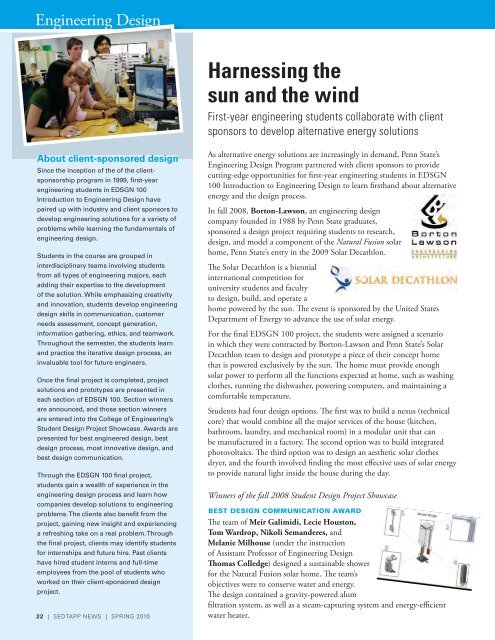Download the PDF - School of Engineering Design, Technology ...
Download the PDF - School of Engineering Design, Technology ...
Download the PDF - School of Engineering Design, Technology ...
Create successful ePaper yourself
Turn your PDF publications into a flip-book with our unique Google optimized e-Paper software.
<strong>Engineering</strong> <strong>Design</strong>Harnessing <strong>the</strong>sun and <strong>the</strong> windFirst-year engineering students collaborate with clientsponsors to develop alternative energy solutionsMOsT INNOVaTIVE dEsIgN awardBEsT ENgINEErINg dEsIgN awardAbout client-sponsored designSince <strong>the</strong> inception <strong>of</strong> <strong>the</strong> <strong>of</strong> <strong>the</strong> clientsponsorshipprogram in 1999, first-yearengineering students in EDSGN 100Introduction to <strong>Engineering</strong> <strong>Design</strong> havepaired up with industry and client sponsors todevelop engineering solutions for a variety <strong>of</strong>problems while learning <strong>the</strong> fundamentals <strong>of</strong>engineering design.Students in <strong>the</strong> course are grouped ininterdisciplinary teams involving studentsfrom all types <strong>of</strong> engineering majors, eachadding <strong>the</strong>ir expertise to <strong>the</strong> development<strong>of</strong> <strong>the</strong> solution. While emphasizing creativityand innovation, students develop engineeringdesign skills in communication, customerneeds assessment, concept generation,information ga<strong>the</strong>ring, ethics, and teamwork.Throughout <strong>the</strong> semester, <strong>the</strong> students learnand practice <strong>the</strong> iterative design process, aninvaluable tool for future engineers.Once <strong>the</strong> final project is completed, projectsolutions and prototypes are presented ineach section <strong>of</strong> EDSGN 100. Section winnersare announced, and those section winnersare entered into <strong>the</strong> College <strong>of</strong> <strong>Engineering</strong>’sStudent <strong>Design</strong> Project Showcase. Awards arepresented for best engineered design, bestdesign process, most innovative design, andbest design communication.Through <strong>the</strong> EDSGN 100 final project,students gain a wealth <strong>of</strong> experience in <strong>the</strong>engineering design process and learn howcompanies develop solutions to engineeringproblems. The clients also benefit from <strong>the</strong>project, gaining new insight and experiencinga refreshing take on a real problem. Through<strong>the</strong> final project, clients may identify studentsfor internships and future hire. Past clientshave hired student interns and full-timeemployees from <strong>the</strong> pool <strong>of</strong> students whoworked on <strong>the</strong>ir client-sponsored designproject.As alternative energy solutions are increasingly in demand, Penn State’s<strong>Engineering</strong> <strong>Design</strong> Program partnered with client sponsors to providecutting-edge opportunities for first-year engineering students in EDSGN100 Introduction to <strong>Engineering</strong> <strong>Design</strong> to learn firsthand about alternativeenergy and <strong>the</strong> design process.In fall 2008, Borton-Lawson, an engineering designcompany founded in 1988 by Penn State graduates,sponsored a design project requiring students to research,design, and model a component <strong>of</strong> <strong>the</strong> Natural Fusion solarhome, Penn State’s entry in <strong>the</strong> 2009 Solar Decathlon.The Solar Decathlon is a biennialinternational competition foruniversity students and facultyto design, build, and operate ahome powered by <strong>the</strong> sun. The event is sponsored by <strong>the</strong> United StatesDepartment <strong>of</strong> Energy to advance <strong>the</strong> use <strong>of</strong> solar energy.For <strong>the</strong> final EDSGN 100 project, <strong>the</strong> students were assigned a scenarioin which <strong>the</strong>y were contracted by Borton-Lawson and Penn State’s SolarDecathlon team to design and prototype a piece <strong>of</strong> <strong>the</strong>ir concept homethat is powered exclusively by <strong>the</strong> sun. The home must provide enoughsolar power to perform all <strong>the</strong> functions expected at home, such as washingclo<strong>the</strong>s, running <strong>the</strong> dishwasher, powering computers, and maintaining acomfortable temperature.Students had four design options. The first was to build a nexus (technicalcore) that would combine all <strong>the</strong> major services <strong>of</strong> <strong>the</strong> house (kitchen,bathroom, laundry, and mechanical room) in a modular unit that canbe manufactured in a factory. The second option was to build integratedphotovoltaics. The third option was to design an aes<strong>the</strong>tic solar clo<strong>the</strong>sdryer, and <strong>the</strong> fourth involved finding <strong>the</strong> most effective uses <strong>of</strong> solar energyto provide natural light inside <strong>the</strong> house during <strong>the</strong> day.Winners <strong>of</strong> <strong>the</strong> fall 2008 Student <strong>Design</strong> Project ShowcaseBEsT dEsIgN COMMUNICaTION awardThe team <strong>of</strong> Meir Galimidi, Lecie Houston,Tom Wardrop, Nikoli Semanderes, andMelanie Milhouse (under <strong>the</strong> instruction<strong>of</strong> Assistant Pr<strong>of</strong>essor <strong>of</strong> <strong>Engineering</strong> <strong>Design</strong>Thomas Colledge) ) designed a sustainable showerfor <strong>the</strong> Natural Fusion solar home. The team’sobjectives were to conserve water and energy.The design contained a gravity-powered alumfiltration system, as well as a steam-capturing system and energy-efficientwater heater.The team <strong>of</strong> Jeff Jesiolowski, Tyler Artz, Dan Butvinik, andByron Pierce (under <strong>the</strong> instruction <strong>of</strong> Assistant Pr<strong>of</strong>essor<strong>of</strong> <strong>Engineering</strong> <strong>Design</strong> Thomas Colledge) recognized <strong>the</strong>inefficiency <strong>of</strong> standby power that is generated by unusedAC adapters that are left plugged into <strong>the</strong> solar home. Theteam’s design eliminated <strong>the</strong> wasted energy by modifying <strong>the</strong>adapters with an on/<strong>of</strong>f switch. An adapter was designed toonly turn on if a device is plugged in.BEsT dEsIgN PrOCEss awardThe team <strong>of</strong> Steven Bates, AmandaMcCloskey, Megan Jurewicz, andMat<strong>the</strong>w Masarik (under <strong>the</strong> instruction<strong>of</strong> <strong>Engineering</strong> <strong>Design</strong> Instructor Brett Ulrich) designedan eco-friendly clo<strong>the</strong>s dryer that is aes<strong>the</strong>tically discrete,cost effective, and minimizes energy usage. The dryer, in <strong>the</strong>form <strong>of</strong> a cedar cabinet, featured white desiccant panels toabsorb moisture and a fan for air circulation. It also had stepsand shelving for easy access and usage; stainless steel rodswith predetermined spacing on which to hang clo<strong>the</strong>s fromstandard clo<strong>the</strong>s hangers; and a concave ceiling, sloped floor,and collection chamber to remove condensation.The team <strong>of</strong> Mike Vashlishan,Jayson Krepps, Greg Cohen,and Pat McDonough (under <strong>the</strong>instruction <strong>of</strong> Assistant Pr<strong>of</strong>essor<strong>of</strong> <strong>Engineering</strong> <strong>Design</strong> Denise Bauer) created a nexus toimprove <strong>the</strong> efficiency <strong>of</strong> <strong>the</strong> solar home. The team tookprice, effectiveness, and functionality into considerationwhen designing <strong>the</strong>ir component.A word from <strong>the</strong> sponsor: Borton-Lawson“The Solar Decathlon project was an amazing opportunityfor Penn State students not only to gain real-life engineeringexperience, but to do so while developing scalable energysolutions. Borton-Lawson was extremely impressed with <strong>the</strong>effort that <strong>the</strong> first-year engineering students put forward. Wefeel that students find <strong>the</strong> industry sponsorship <strong>of</strong> <strong>the</strong>se projectsto be extremely relevant, as it gives <strong>the</strong>m an understanding <strong>of</strong>what <strong>the</strong>y will be doing as engineers when <strong>the</strong>y graduate.“It was exciting to observe <strong>the</strong> student teams as <strong>the</strong>y quicklylatched onto <strong>the</strong> project’s <strong>the</strong>me and began to provideinnovative and energy-efficient design concepts for daylighting,harnessing <strong>of</strong> solar power, and mechanical systems for <strong>the</strong> solarhouse. It is my hope that <strong>the</strong>se students will take <strong>the</strong>ir newlyacquired engineering skills and seize opportunity in <strong>the</strong>ir futuredesigns to help continue producing energy-efficient productsand processes.“It is with a great sense <strong>of</strong> pride, and our privilege, to help guideyoung engineers to realize that <strong>the</strong>ir future energy-efficientdesigns can make a difference to continue development andfoster a better life for villages, cities, or even entire countries.”A.J. Speicher Jr., P.E.Senior Mechanical Engineer, Borton-Lawsonaspeicher@borton-lawson.com22 | SEDTAPP NEwS | SPriNg 2010 SPriNg 2010 | SEDTAPP NEwS | 23



